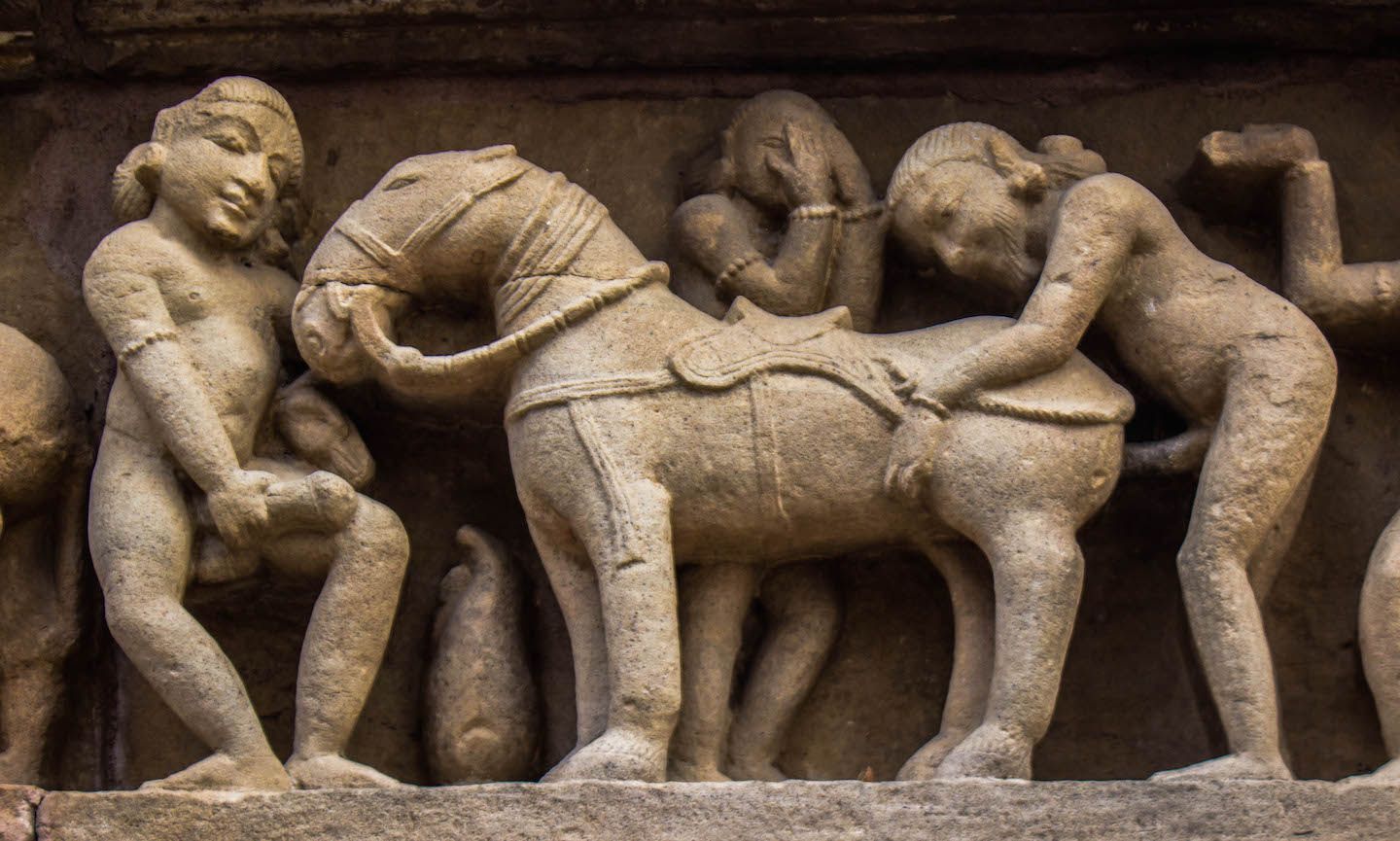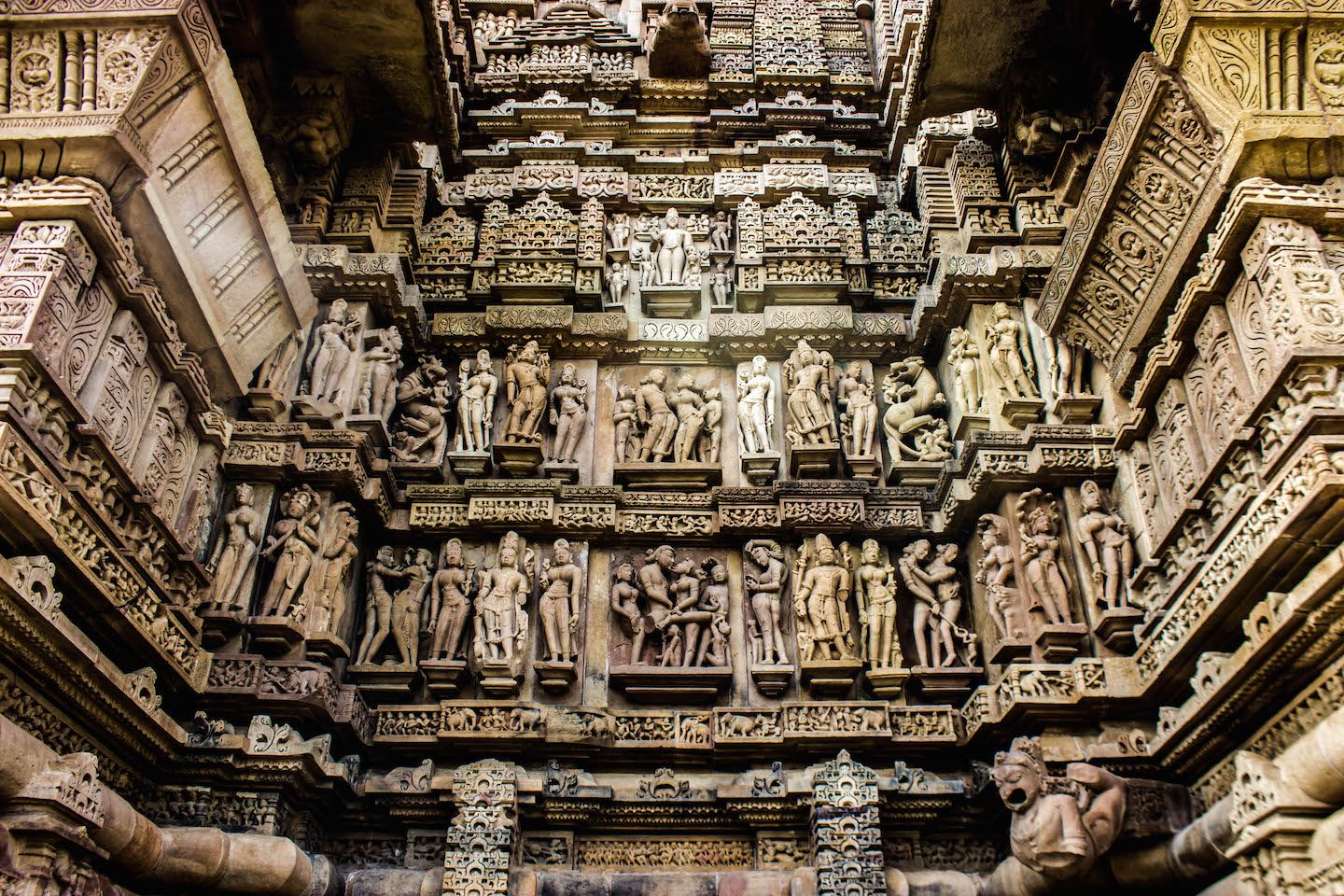From the holy and one-of-a-kind Varanasi, we headed to the quiet Khajuraho. A small town about halfway between Varanasi and Jaipur, it was a good place to calm down after Varanasi days. Known for its temples built during the Chandela dynasty, Khajuraho didn’t resemble the chaotic India we were used to. The streets were much more calm and deserted than usual.

Our overnight train from Varanasi arrived early in the morning at 5am. Khajuraho was not very big, and as such, our guesthouse was literally across the street from the western group of temples (the most important ones). We could see them from our window. After settling down and dropping off our backpacks, we went straight to the temples before the heat of the day began – they opened at sunrise. With audio guides in hand, we were ready to sight-see in the early morning and be done by the time the real heat of the day hit.

The temple park was extremely well-kept. There were clear marked paths with signs and corresponding audio guide numbers. No rubbish anywhere, everything was clean, and it was quiet and calm and slightly breezy. Anyone who’s ever been to India can tell you that it’s near impossible to find a public place like this. We savoured it for all its worth.

Following the indicated audio guide route, one of the first stops was the Varaha temple. Dedicated to Vishnu’s boar incarnation, it was a small shrine with a giant boar statue. On the surface of the boar, countless gods were meticulously carved into place, a pantheon of gods. The temple had been built around 900 CE and despite a few missing statues, it looked well-preserved.

Right in front of the Varaha temple, the larger Lakshmana temple stood out. After nearly 20 years of construction, the Lakshmana temple served as a preview of the even bigger Kandariya-Mahadev temple. Many sculptures were carved on the temple plinth, picturing the daily life of locals at the time of its construction. As we circled the base carefully, we had our first glimpses of the famous erotic sculptures of Khajuraho.

Even though only 10% of all sculptures in the temples contain erotic content, they are undoubtedly the ones that receive the most attention from the public and what the temples in Khajuraho are primarily known for. No wonder. The sculptures were rather explicit and liberal, showing people in very intimate moments or scandalous positions. It’s common for structures to have sexual allusions, such as phallic symbols, but we have never been to temples that illustrated humans engaged in all kinds of sexual positions in such detail. The more exotic ones even involved other animals…

Some scholars suggest that the sculptures were part of common tantric sexual practices at the time, while others say that it was part of the Hindu tradition of treating desire as essential to human life. Whatever the reason, the artists and sculptors did a great job representing this part of human behavior. Besides the couples, many sculptures depicted curvaceous nymphs in a variety of activities, such as dancing or playing.

The masterpiece of the Khajuraho Group of Monuments was the Kandariya-Mahadev temple. The epitome of Chandalean architecture, the Kandariya-Mahadev was the biggest temple in town and home to several acrobatic sculptures, some of the spiciest in the whole group. Both the northern and southern walls of the temple illustrated what could surely be a page of the Kama Sutra. Many of the couples were depicted in twisted positions while receiving necessary support from others to keep them in those positions. The supporters usually watched the scene and “helped” themselves as well.

When the British surveyor T.S. Burt rediscovered the temples, he found the sculptures obscene and outrageous. While it is always a bit uncomfortable to observe sexual acts, we found the idea of sex and religion being interconnected to be fascinating. The Hinduism belief was that through a close embrace, one can reach moksha, or in other words, nirvana, freedom, and self-actualization. So not only was pleasure and sensuality an essential part of human life, it was a way to be liberated from the cycles of birth and death. It was a way to reach purity of self, mental peace, and one’s union with God.

A few other smaller and less significant temples finished our visit to the western group of monuments in Khajuraho. Just in time, as by 10am, the sun was starting to become unbearable. We headed back to our guesthouse to catch up on some sleep before leaving the next day for Jaipur, and the beginning of our exploration of Rajasthan. We have visited way too many temples on this trip, but somehow I think we will remember these ones at Khajuraho for a long time.
For more pictures from Khajuraho, please visit the gallery!

